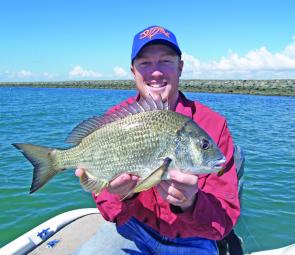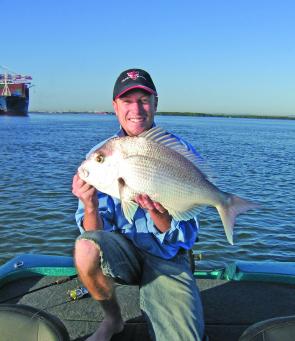There is a smorgasbord of fish available for anglers in the smaller bay islands and the mouth of the river. Jew, snapper, estuary cod, tailor, bream, flathead, whiting and squid are available in decent numbers during daylight hours and even better at night.
When the wind holds enough to get out to the islands, night sessions are producing better quality fish. The techniques used during the day are working even better during the cold windy winter nights.
In winter, Jew are found in larger numbers towards the mouth of the river and in the deeper holes around the islands. Live baits, like tailor and mullet, are working well at present. However, keeping the small sharks off the baits can sometimes be impossible. Soft plastics like Ecogear 4” and 5” Power Shads and large vibration baits, like Jackall Mask 60/70, are definitely the better option if the fish are visible on the depth sounder.
Good numbers of snapper have been found from the Gateway Bridge to the mouth of the river. Shallow presentation is the key, with the majority of fish feeding on the bait towards the surface. Even when fishing the loading terminals towards the mouth in deep water, the snapper will most likely be feeding in the top half of the column.
Around the islands and the newly reclaimed section at the mouth, the fish will be in the shallows feeding on the readily available bait schools. Snapper become easily spooked during the day, so after dark is a good time to target them. Whilst I was fishing for squid at night, snapper started to engulf 2.5 jigs and destroyed us on 4lb tackle. The snapper can be big and really take some stopping.
Estuary cod are always available in reasonable numbers. Every year the bait schools show up and inhabit the shallows in incredibly large numbers, enticing the cod to follow. These fish have become a saviour for many an angler when nothing else wants to bite.
Cod are relatively easy to catch as they will eat artificial, dead and live baits. They are very aggressive feeders, often eating baits much larger than them-selves. A good technique to use in the shallows is to cast small lures, like Ecogear CK50 FO3 or shallow running lures, and slowly retrieving them just above the bottom. Slow trolling the same style lures will produce excellent results. Continually moving, covering large areas will produce better results then staying in the same area peppering a bay or a point with continuous casts. It’s worth taking home a feed of estuary cod because they are top quality chewing.
Tailor season is in full swing with great catches of fish coming from the mouth of the river around the newly reclaimed section and amongst the reefed sections around the islands. Early mornings and late afternoons are the traditional bite periods for tailor, but they can be caught during the middle of the day as they feed on bait schools near the surface. Casting small chrome slugs, soft plastics or small flies to surface feeding tailor is a real buzz. Pilchards fished unweighted or suspended under floats are working well, especially after sunset.
Bream are moving around at the moment. One day they will be holding close to structure, ambushing the schools of baitfish, and the next day they will move off into deeper areas where snapper and sweetlips like to hang. Spawning bream around the islands are hit and miss. When you find them, they are usually in good numbers. It pays to start looking in the shallow and move deeper into 6’-10’ of water.
Whiting season never seems to disappear in the southeast. The flats at the mouth of the river and between the mouth and Mud/St Heliena Islands always hold good quantities of whiting. Bramble Bay and the flats in front of the small creeks are also good whiting areas. Live bait, like worms, are definitely the best option if wanting a feed. Larger fish will eat surface lures or plastics and diving minnow in the shallows on calm clear winter mornings. Target the weedy flats at the mouth of the river and the boat passage or around the inside of Mud, St Helina and Green.
Flathead are like whiting and hang around the mouth of the river. They increase in numbers and you can target them on any given day. At present, they are numerous around any of the sandy areas towards the mouth. Target drains and run-offs on the falling tides for best results. Flathead will eat just about anything that swims past them, so live baits, small strip baits and artificial offerings work well. The flats around the oil pipe at the mouth will be well worth a look for the next few months.
Squid are plentiful throughout the winter months. They put up a good fight on light tackle and will definitely sharpen your sight fishing ability. Shallow weeded/reefed/rocked areas that have clean tidal water will hold squid. All the above-mentioned structures around Moreton Bay have never failed to produce squid in the last couple of years.
Reads: 2745
Some big bream will be around any structure in the Brisbane River now. Be aware of access restrictions and go catch yourself a few.

Big snapper are a favourite of soft plastic fishers in the Brisbane River and August is a great month to target them.




